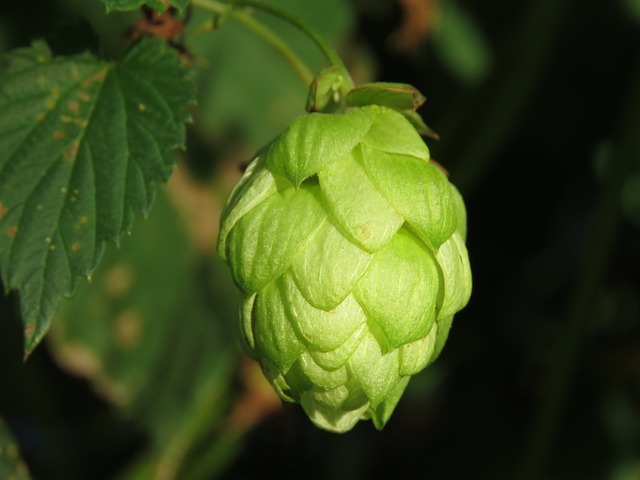Hops; Humulus

This is about hops including its hormonal properties, and use for breast enlargement and hormone balance.
Etymology
The genus of hops goes by the scientific name of Humulus. It belongs to the Cannabaceae family.
Properties
Hops lowers FSH and LH, and it indirectly raises prolactin. The potent phytohormone 8-prenylnaringenin (8PN) from Humulus was found to have this hormonal effect. 8PN is also a powerful estrogen analog that is specifically an agonist of ERα which effects are shown in the breasts. In small amounts, hops sensitizes progesterone receptors.
Use
Humulus for breast enhancement
Hops can be taken during secretory phase.
Hops should not be taken in any combination during proliferative phase and ovulation, as this can cause breast shrinking and contribute to hormone imbalances.
Specific herb programs using hops that cause breast growth can be seen in hops01, anon03 and hirsutism02.
Humulus or herbs with similar properties are in herb programs based on menstrual phases. There must be balance throughout phases, and combinations of herbs help the body acheive balance for health, breast growth and hip growth. It's important that menses is light and short. Also, preventing an excess of negative symptoms for menses helps set the balance for proliferative phase. Luteal phase uses a different combination of herbs than proliferative phase for symptoms. For a simplified herb schedule, where there's commonality of herb recommendations for symptoms such as swelling and signs of excess estrogen, use nonmenses. BCP01 is a composite page of pieces of different programs on birth control or IUD use.
Herb timing and combinations' success for breast enhancement relies on menstrual phases. Descriptions and pictures of results from herb combination use can be seen in programs. For more guidance, see guide, or hirsutism-topic.
Similar herbs
Blessed milk thistle (Silybum) also increases prolactin. Silymarin contained in thistle upregulates ERβ, so it would likely require different companion herbs than hops.
Black cohosh (Actaea) can lower LH perhaps similarly to hops. However, black cohosh isn't recommended.
Precautions
Handling or ingesting hops during proliferative or ovulation can cause hormone imbalances. It is also expected to worsen mood, if taken during this time.
Humulus can also act as a serious irritant, especially during proliferative and ovulation. Some show allergic reactions to hops, even by touch, so proliferative and ovulation may be the time where its symptoms can be worse. Wash hands and scrub fingernails thoroughly to prevent hops oils from spreading, if this is the case. Anti-histamines (over counter allergy medication) and fiber (not from foods containing phyto-estrogens) should help. Sunflower seed seemed to cause a slight improvement in hormone balance and from allergic-like symptoms.
See precautions for more details of care to be taken with herb use. Proper nutrition is a consideration for health. Also, check for the latest blog updates about herb and hormone safety.
It is very important that menses be light and not prolonged.
If you have hirsutism, PCOS, hot-flashes, other signs of hormone imbalances, see estrogen-imbalance, and hirsutism program journals at hirusitism-topic before trying herbs.
Herb concentrates can be tens of times more potent by weight than herbs in solid form. This can easily lead to hormone imbalances. For this reason, concentrate extracts are not recommended for extended or excessive internal use, especially during fertility years. Concentrates shouldn't be used to overcome plateaus. Another issue with herbal extracts, is that they may not have the full range of properties of the herb. Essential oils are not recommended for breast enhancement. If opting to use herbal extracts, use food grade extracts, with no more than 1 drop at a time diluted in water.
More


For the latest herb programs and how to get started, see: guide. Pictures of breast enhancement can be seen in the program journals of Anon02, Anon08, Anon09, Bubblemelon and Jellie.
For resources on hips and butt enhancement, see: /appendix/hips-butt-enhancement and /appendix/kettlebell.
breast-endocrinology.pdf describes the science of breast development and endocrinology. It also describes symptoms related to hormone imbalances. Biology and hormone imbalances are excerpts from this ebook. breast-endocrinology.pdf uses a Creative Commons (CC BY-ND 4.0) license.
Breast.is blog
References:
- In vivo estrogenic comparisons of Trifolium pratense (red clover) Humulus lupulus (hops), and the pure compounds isoxanthohumol and 8-α prenylnaringenin. https://www.ncbi.nlm.nih.gov/pubmed/18619951.
- Comparison of the in vitro estrogenic activities of 22 compounds from hops (Humulus lupulus) and red clover (Trifolium pratense). https://www.ncbi.nlm.nih.gov/pmc/articles/PMC1815392/.
- Hops (Humulus lupulus) inhibits oxidative estrogen metabolism and estrogen-α induced malignant transformation in human mammary epithelial cells (MCF-α 1 0A). https://www.ncbi.nlm.nih.gov/pmc/articles/PMC3252489/.
- Therapeutic Perspectives of 8-Prenylnaringenin, a Potent Phytoestrogen from Hops. https://www.ncbi.nlm.nih.gov/pmc/articles/PMC6017581/.
- The pharmacognosy of Humulus lupulus L. (hops) with an emphasis on estrogenic properties. https://www.ncbi.nlm.nih.gov/pmc/articles/PMC1852439/.
- "Bust enhancing" herbal products. https://www.sciencedirect.com/science/article/pii/S0029784403003624.
- Hop Extracts and Hop Substances in Treatment of Menopausal Complaints. https://www.thieme-connect.com/products/ejournals/html/10.1055/s-0032-1328330#RW1185-42.
Etymology & Definitions:
- USDA Plant profile: Humulus. https://plants.usda.gov/core/profile?symbol=HUMUL.
Resources:
- Medline Plus: Hops. https://medlineplus.gov/druginfo/natural/856.html.
